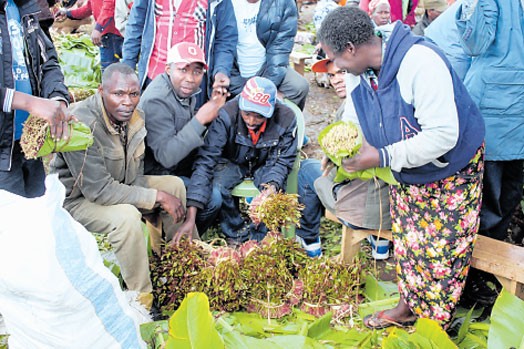
Miraa traders at Maua market bundles freshly harvested twigs for transport. The crop provides income for over 250,000 Kenyans, especially in Meru County where miraa farming dominates the local economy. Photo/Courtesy
By Daisy Okiring
“Over 70% of households in Meru County rely on miraa for their primary income.”
This powerful statistic underscores the socio-economic lifeline miraa provides in Kenya’s Meru region. In towns like Maua and Laare, the sight of green-tipped stems being bundled and hurried onto pickup trucks is a daily ritual—one that powers an entire regional economy.
Yet beyond the hills of Meru, the very same crop ignites controversy. To some, miraa (also known as khat) is a harmless tradition, a cultural symbol of hospitality and pride. To others, it’s a dangerous substance, associated with addiction, family instability, and economic stagnation.
As Kenya seeks to balance tradition with regulation, the debate over miraa has become a flashpoint—where economics, ethics, and identity collide.
Economic lifeline in Meru
Miraa cultivation supports a vast web of activity in Kenya’s eastern counties. According to a policy brief by Kenya’s Ministry of Agriculture, the miraa value chain employs more than 250,000 people, including farmers, pickers, transporters, and traders. In Meru County alone, the sector injects an estimated KES 10–15 billion (USD 75–110 million) into the economy annually.
Read more: Kawira Mwangaza: The final blow to Meru’s political ‘lioness’
For decades, this trade has enabled rural households to pay school fees, build homes, and invest in other agricultural ventures. The crop’s short maturation period and year-round harvest potential make it a reliable income source, especially in regions with limited access to other cash crops.

One of the most compelling validations of miraa’s importance came from former Agriculture CS Peter Munya, who described it as “a key economic driver in Meru… that should not be criminalised but regulated.”
Cultural significance vs social concerns
In Meru, miraa is more than an economic asset—it is woven into the community’s social and cultural fabric. It is chewed in council meetings, offered during negotiations, and used in rituals. But its use is not without critics.
A 2020 study published in Sustainability explored the deep-seated tensions surrounding miraa. Researchers noted that in urban and non-farming communities, the practice is increasingly seen as detrimental. Religious leaders and health officials have expressed concerns about the stimulant’s long-term effects, particularly among youth and low-income users.
According to the study, “In counties such as Isiolo, Mombasa, and Nairobi, miraa is associated with youth idleness, moral decay, and family breakdown.” These associations have led to regional restrictions, bans in public spaces, and rising calls for national regulation.
Dr. Faith Wanja, one of the study’s lead authors, stated:
“The consumption of miraa is a contested social practice. While users see it as a mild stimulant with cultural and economic value, critics associate it with addiction, poverty, and family neglect.”
This duality—miraa as both sustainer and destroyer—fuels Kenya’s ongoing cultural rift.
Global perception and trade fallout
The miraa economy once extended well beyond Kenya’s borders. Somalia, the UK, and the Netherlands were top importers of Kenyan khat, contributing significantly to export revenues. But the tide turned in 2014, when the United Kingdom banned miraa, reclassifying it as a Class C drug. The Netherlands followed suit shortly after.

These bans were deeply felt in Kenya. According to the Kenya National Bureau of Statistics, exports of miraa dropped by over 60% between 2014 and 2016. Entire supply chains collapsed, and thousands of traders—especially women involved in cross-border transport—lost their livelihoods overnight.
Read more: How innovations are transforming farming in Central Kenya
In response, the Kenyan government designated miraa as a scheduled crop under the Crops Act in 2016, making it eligible for state support. However, efforts to re-enter banned markets have been unsuccessful, with international authorities citing health concerns and regulatory constraints.
In the Sustainability article, researchers observed that:
“Although science around the health effects of miraa remains inconclusive, public perception—particularly among diaspora communities—has played a significant role in shaping policy abroad.”
This quote reflects how global decisions about miraa often stem not only from evidence but also from cultural and political contexts far removed from Meru’s farmlands.
Health, gender, and generational impacts
While miraa brings economic relief, its widespread consumption has also raised health red flags. The World Health Organization classifies khat as a psychoactive substance that can cause insomnia, digestive issues, and, with prolonged use, psychological dependence. In Kenya, health workers in urban slums have noted a rise in patients reporting anxiety, dehydration, and oral complications associated with daily chewing.
The impact is also gendered. Many women are involved in selling miraa, but fewer are consumers. Yet they bear the brunt of social consequences—especially when their partners or sons spend family resources on chewing sessions that can last for hours.
A 2021 NACADA report found that 32% of male miraa users between ages 18–35 chew it at least five times a week, often in groups that double as informal clubs. Such habits, the report warned, can negatively affect family responsibilities and employment stability.
Moreover, in some areas, the economic appeal of miraa has drawn youth away from formal education. Short-term gains often outweigh long-term planning, especially where few alternatives exist.
Regulation, not rejection
The Kenyan government faces a delicate balancing act. Outright bans are likely to provoke backlash from regions that depend on the crop. At the same time, public health, urban governance, and international diplomacy demand accountability.
Experts recommend a regulatory framework that includes:
- Zoning and licensing of vendors
- Age restrictions and health warnings
- Incentives for crop diversification
- Community education programs
These steps could preserve the economic benefits of miraa while minimizing its social harms.
A crop at the crossroads
Miraa’s story is more than a tale of a controversial plant—it is a reflection of Kenya’s broader struggle to reconcile tradition with modernity. In Meru, it symbolizes survival and pride. In cities and abroad, it raises questions about morality, identity, and health.
Read more: Rearing hope: Nourishing a hungry world through sustainable agriculture
As Kenya charts its future, the miraa debate offers a potent reminder: solutions must be nuanced, inclusive, and informed by both science and lived experience. The challenge is not to demonize or glorify the crop—but to understand it in all its complexity.



